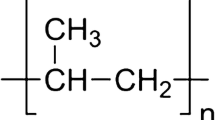Abstract
QSPR modeling has been performed on 38 organic peroxides against onset temperature. The molecular structures were optimized and frequencies were computed with DFT/b3lyp and 6-311g(d,p) basis set. Avogadro 1.2 was used to Convert gaussian output files to MDL SDFile format. 5666 molecular descriptors were calculated by Alvadesc software based on MDL SDfiles. The data set is randomly divided into training and test sets, and the number of samples contained in the training and test sets are 30 and 8, respectively. A seven-parameter relationship was established by the stepwise multiple linear regression method. The correlation coefficient reaches 0.9843, and the RMSE for the training and test sets are 5.47 and 5.57, respectively. Student t-value, VIF value and Durbin–Watson value indicate that all the independent variables have significant impact on dependent variable, and there is no multicollinearity between independent variables and no correlation between the residuals, respectively. LOOCV, LMOCV, external validation, Application domain analysis show that the resulting QSPR model is robust and reliable and can be used to predict the thermal decomposition temperature of organic peroxides.




Similar content being viewed by others
REFERENCES
Y. Dai, L. Niu, J. Zou, et al., J. Centr. South Univ. 25, 1535 (2018).
Y. Lu, D. Ng, and M. S. Mannan, Ind. Eng. Chem. Res. 50, 1515 (2011).
V. Prana, P. Rotureau, G. Fayet, et al., J. Hazard. Mater. 276, 216 (2014).
R. H. Chang, J. M. Tseng, J. M. Jehng, et al., J. Therm. Anal. Calorim. 83, 57 (2006).
L. C. Tsai, M. L. You, M. F. Ding, et al., Molecules 17, 8056 (2012).
J. Lv, W. Chen, L. Chen, et al., Thermochim. Acta 589, 11 (2014).
Y. Zhang, Y. Pan, J. Jiang, et al., J. Environ. Chem. Eng. 2, 868 (2014).
Q. Wang, L. Wang, X. Zhang, and Z. Mi, J. Hazard. Mater. 172, 1659 (2009).
J. Lv, L. Chen, W. Chen, H. Gao, and M. Peng, Thermochim. Acta 571, 60 (2013).
P. Y. Yeh, C. M. Shu, and Y. S. Duh, Ind. Eng. Chem. Res. 42, 1 (2002).
M. Malow and K. D. Wehrstedt, J. Hazard. Mater. 120, 21 (2005).
T. A. Albahri, Chem. Eng. Sci. 58, 3629 (2003).
N. Zohari, M. H. Keshavarz, and Z. Dalaei, J. Therm. Anal. Calorim. 125, 887 (2016).
R. Huoyu, Z. Zhiqiang, L. Zhanggao, et al., Int. J. Quantum Chem. 122, e26950 (2022).
M. Y. Dolomatov, T. M. Aubekerov, O. S. Koledin, K. R. Akhtyamova, E. V. Vagapova, and E. A. Kovaleva, Russ. J. Phys. Chem. A 93, 2388 (2019).
R. Huoyu, Z. Zhiqiang, J. Guofang, et al., Russ. J. Phys. Chem. A 96, 2329 (2022).
M. Y. Dolomatov, E. A. Kovaleva, N. S. Valeeva, and N. Kh. Paimurzina, Russ. J. Phys. Chem. A 94, 2189 (2020).
K. Lakzian, S. Hosseiniallahchal, H. J. Salmani, et al., Thermochim. Acta 691, 178719 (2020).
E. Torabian and M. A. Sobati, Thermochim. Acta 672, 162 (2019).
B. Wang, H. Yi, K. Xu, et al., J. Therm. Anal. Calorim. 128, 399 (2017).
Y. Gao, Y. Xue, Z. Lü, et al., Process. Safety Environ. Protect. 94, 322 (2015)
P. He, Y. Pan, and J. Jiang, Proc. Eng. 211, 215 (2018).
W. Li, G. Song, J. Zhang, et al., Comput. Theor. Chem. 1202, 113324 (2021)
Ö. Ç. Havare, Int. J. Quantum Chem. 121, e26813 (2021).
A. Mauri, in Ecotoxicological QSARs, Ed. by K. Roy (Springer, 2020), p. 801. https://doi.org/10.1007/978-1-0716-0150-1_32
S. Saaidpour, Phys. Chem. Res. 4, 61 (2016).
K. Roy, S. Kar, and R. N. Das, in Understanding the Basics of QSAR for Applications in Pharmaceutical Sciences and Risk Assessment (Academic, Boston, 2015), Chap. 7, p. 231.
ENV/JM/MONO(2007)2, OECD Environment Health and Safety Publ., Ser. on Testing and Assessment, No. 69 (OECD,Paris, 2007).
K. Roy, I. Mitra, S. Kar, P. K. Ojha, R. N. Das, and H. Kabir, J. Chem. Inform. Model. 52, 396 (2012). https://doi.org/10.1021/ci200520g
Sh. Shen, Y. Pan, X. Ji, Yu. Ni, and Ju. Jiang, Int. J. Mol. Sci. 20, 2084 (2019). https://doi.org/10.3390/ijms20092084
R. K. Mukherjee, V. Kumar, and K. Roy, Environ. Sci. Technol. 56, 335 (2021).
K. Roy and R. N. Das, in Pharmaceutical Sciences: Breakthroughs in Research and Practice (IGI Global, 2017), p. 978.
Author information
Authors and Affiliations
Corresponding author
Ethics declarations
The authors declare that they have no conflicts of interest.
Rights and permissions
About this article
Cite this article
Yuting, L., Fangrui, J., Huoyu, R. et al. Correlation between the Onset Temperature and Molecular Descriptors of Organic Peroxides. Russ. J. Phys. Chem. 97, 2550–2558 (2023). https://doi.org/10.1134/S0036024423110195
Received:
Revised:
Accepted:
Published:
Issue Date:
DOI: https://doi.org/10.1134/S0036024423110195




